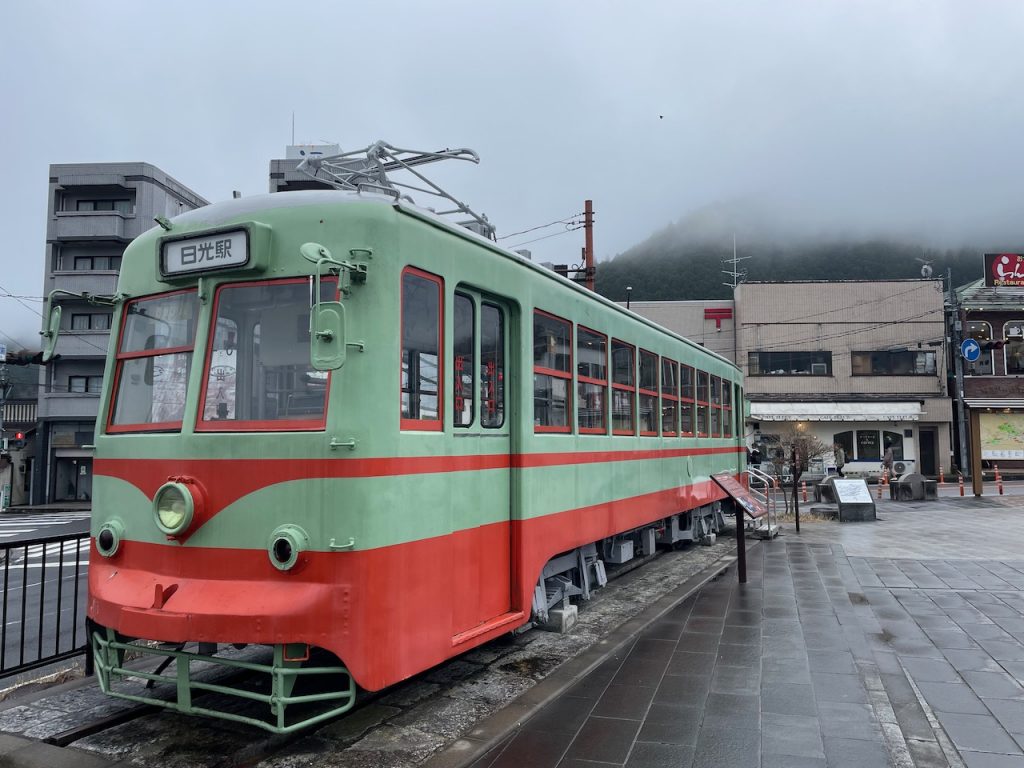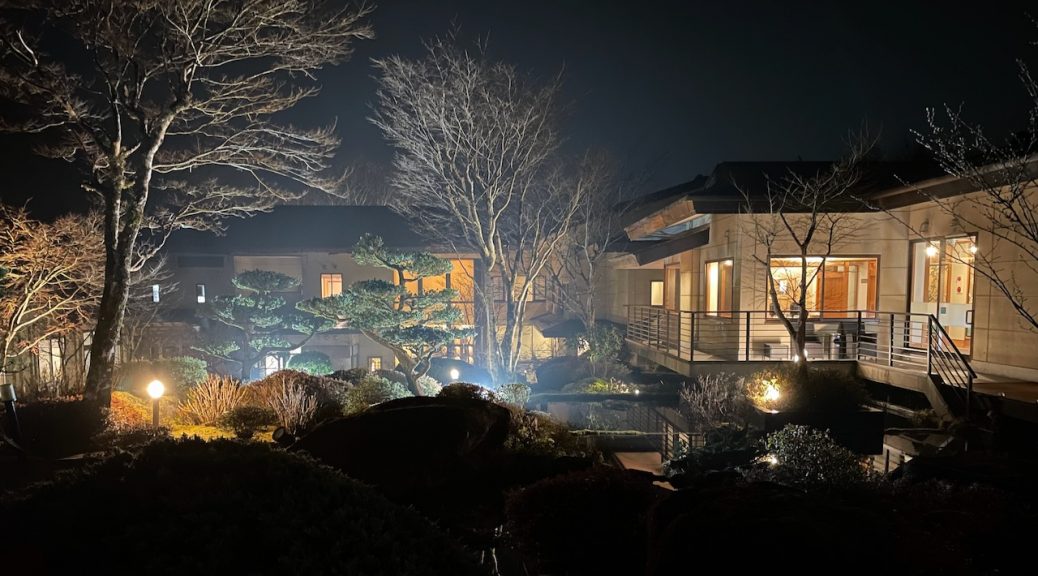
Nikko Ryokan (and Rhett eats a smol squid)
In Nikko, we are doing something I have always wanted to do: staying at a traditional onsen ryokan (hot spring hotel), and having kaiseki (a traditional course meal). This particular stay is brought to you by the combination of the yen being incredibly weak and my airfare being a rewards ticket and thus, costing me nothing but fake airline currency built up as credit card spending during the pandemic.
The ryokan booking is much more of a negotiation process as a vegetarian (a relatively non-strict one) and many ryokan that serve kaiseki won’t accommodate you. After several days of back and forth via email in English and in Japanese, I coerced Oku-no-in Tokugawa in Nikko into accommodating me. Yes, I eat egg and milk. No, I don’t mind dashi (soup stock made with bonito fish flakes). You would imagine that for 90k yen a night for two people, in a country with strong Buddhist and therefore vegetarian roots, it would be easier to get your vegetarian dietary whims catered to. But this is Japan and it does what it does. Speaking the language helps a ton during this process and we eventually were gucci.
Kaiseki is heavily rooted in the joys of seasonality and what is available at that particular time of year. Your fish, meat, and vegetable and other sides will rotate based on when and where you are getting kaiseki. It is a multi-course meal and represents the pinnacle of traditional Japanese haute cuisine.
And it is now perhaps the time to tell you about the amount of cultural synchronicity that Japan has with seasonal change. Seasonal tourism is huge here – the country is gripped with hydrangea mania after the rainy season, delights in the changing leaves in November, and goes absolutely nutter butter for the cherry blossom season in April. April is generally when the school year starts and is viewed as a good time for new beginnings. There are special foods and flavors you can find in every season or for every holiday that will stop as soon as that time period is over. And it doesn’t creep earlier, like Christmas seems to do every year. Stay in December, Christmas.
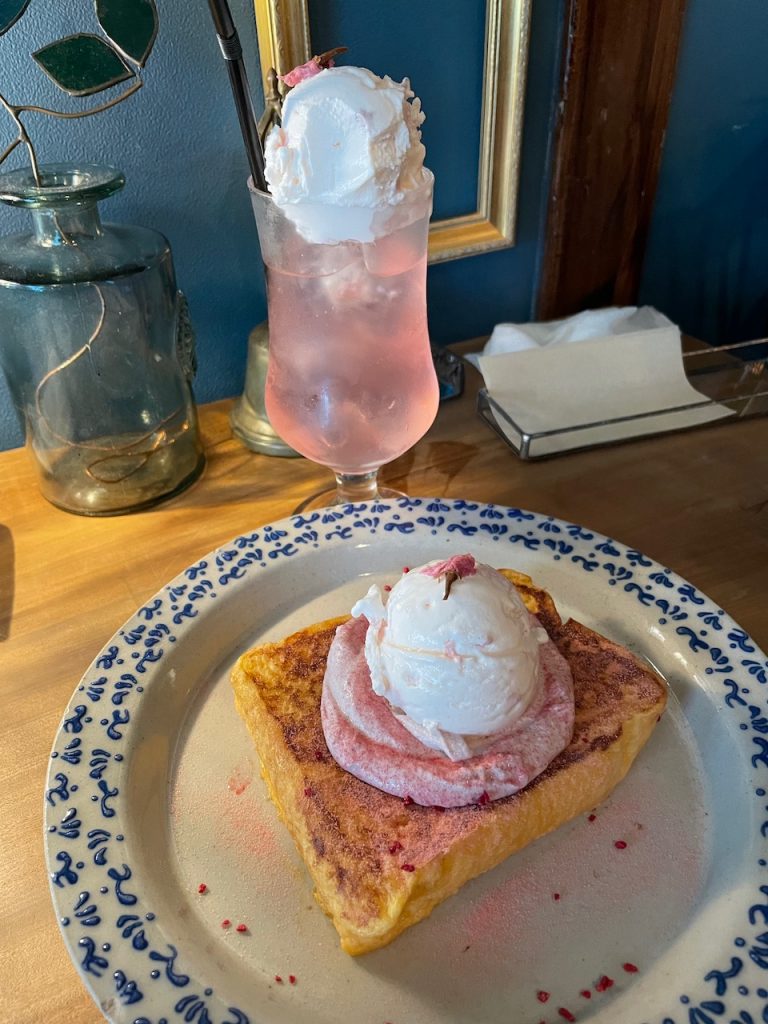
While we do have that at home, I don’t think it has as strong as a pull, outside of Christmas and Thanksgiving. Coincidentally, these are some of my most favorite times of the year, perhaps precisely because of the food traditions that come with those seasons. This is probably one of my most favorite things about Japanese culture, the celebration of the passing impermanence of each season.
If you couldn’t guess, there are loads of cherry blossom things everywhere right now, even if those jerk trees are being slow: you can get sakura in street foods, convenience store candy, and in kaiseki and welcome gifts when we check into our fancy hotels.
And this picture sums up the tourism relatively nicely:
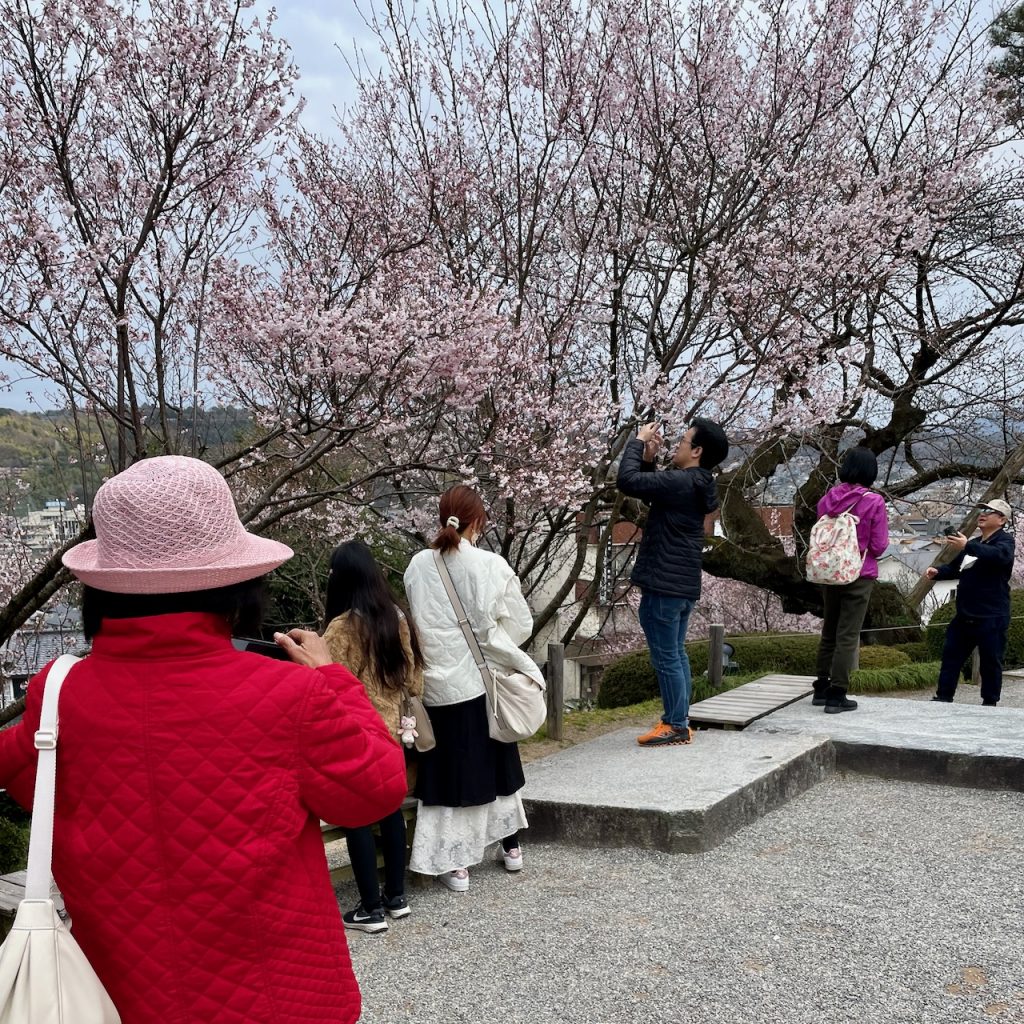
Anyway, Nikko. We have a rental car here because 1 – the yen is weak so it’s cheap and 2 – I don’t want to be beholden to the hotel’s shuttle schedule or the Nikko bus system.
We arrive too early to check in, so we picked up our rental car and went to Toshogu, which is where Tokugawa Ieyasu is interred. You learn about him ad nauseam in Japanese history, as he united the country and ushered in the final age of samurai rule, which lated about two centuries starting in the 1600s. His shrine has a ton of gold everywhere, amidst massive cedar trees. The gates are carved ornately. Someone who Totally Knew What An Elephant Looks Like carved some elephants into the side of one of the buildings.
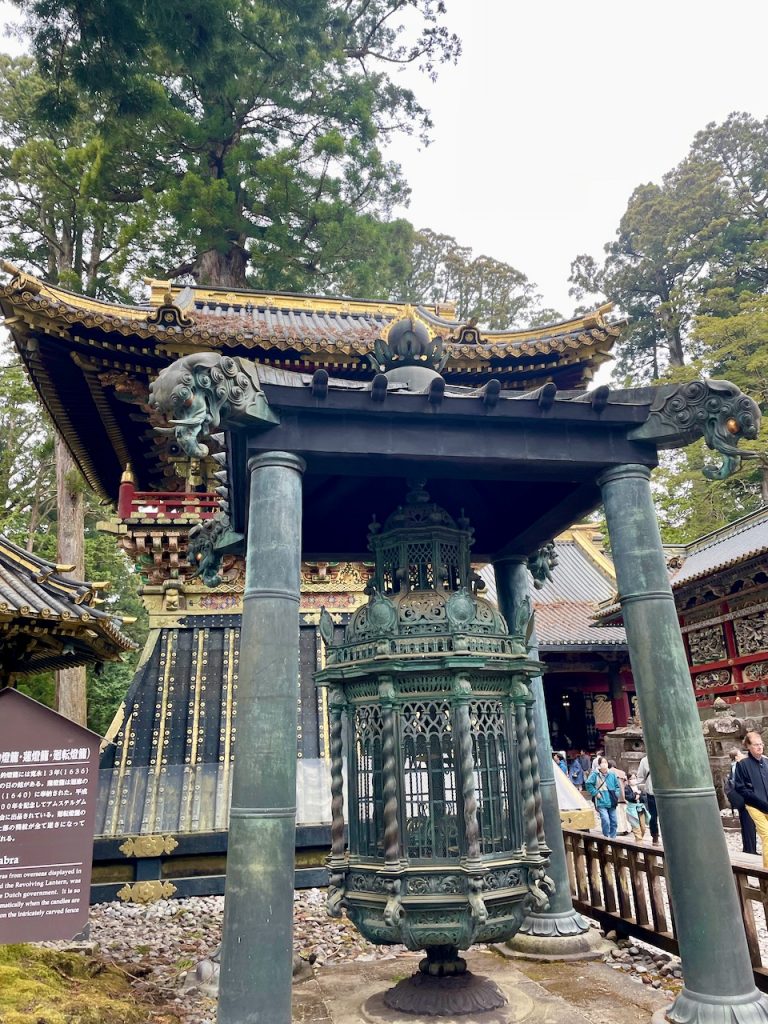
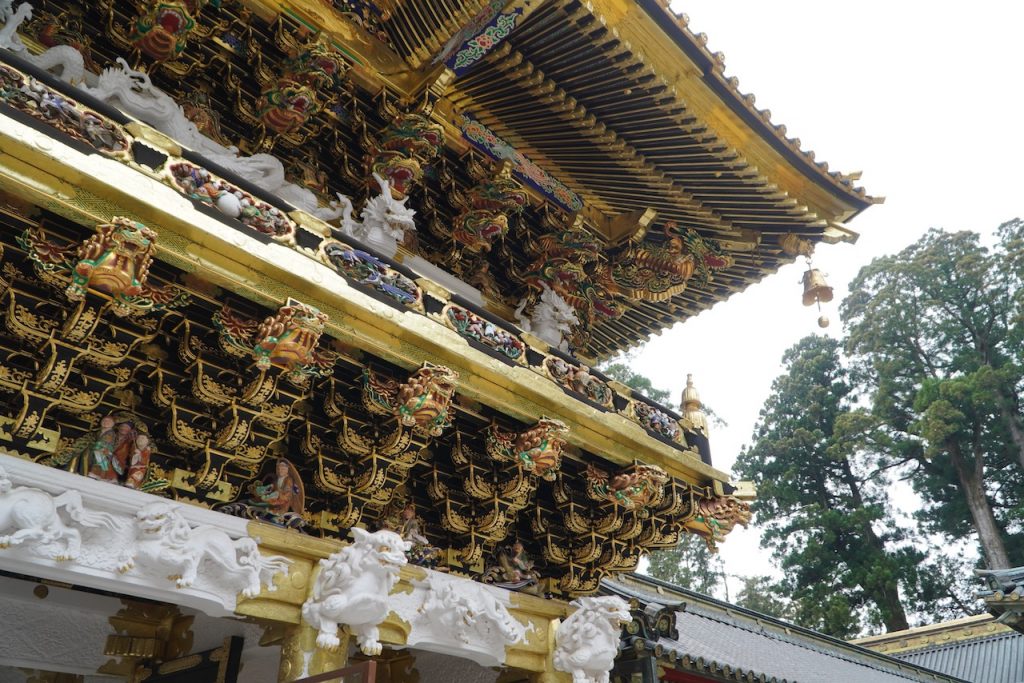
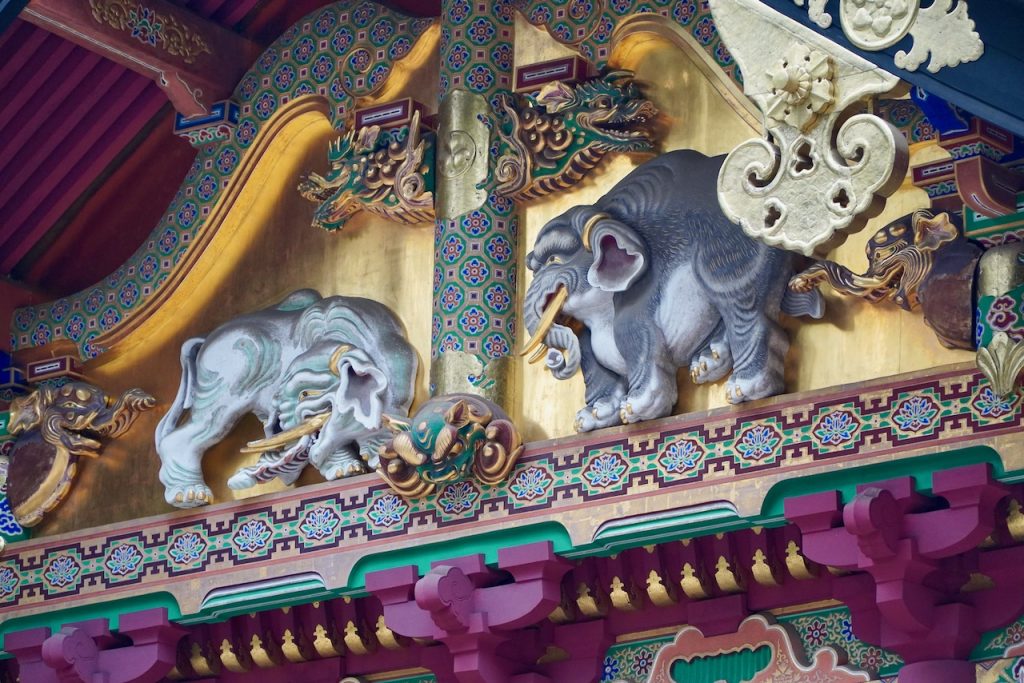
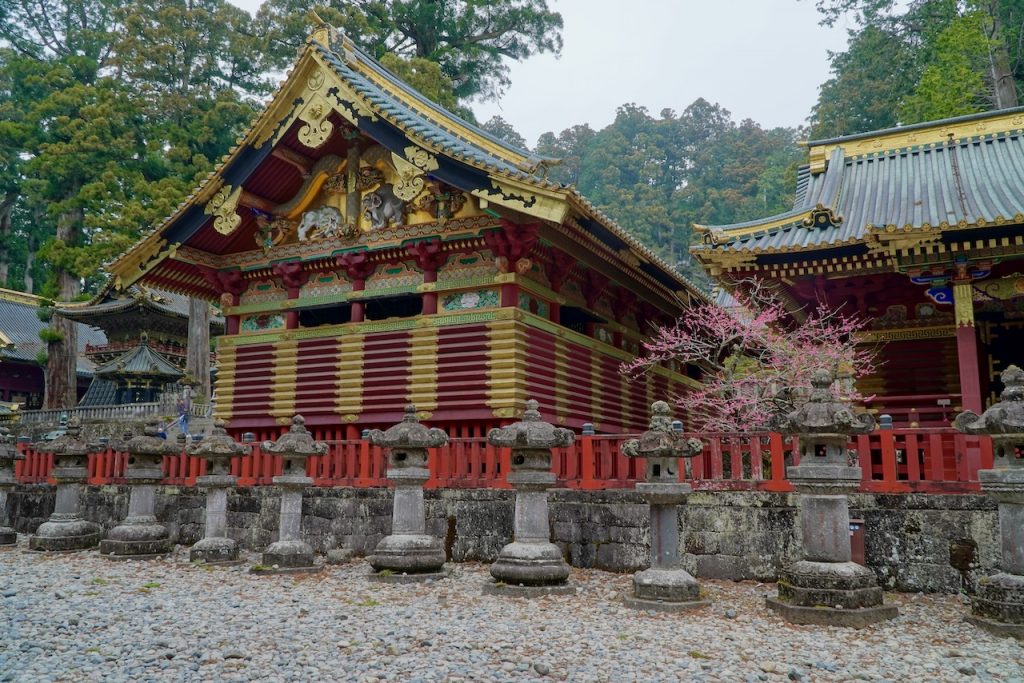
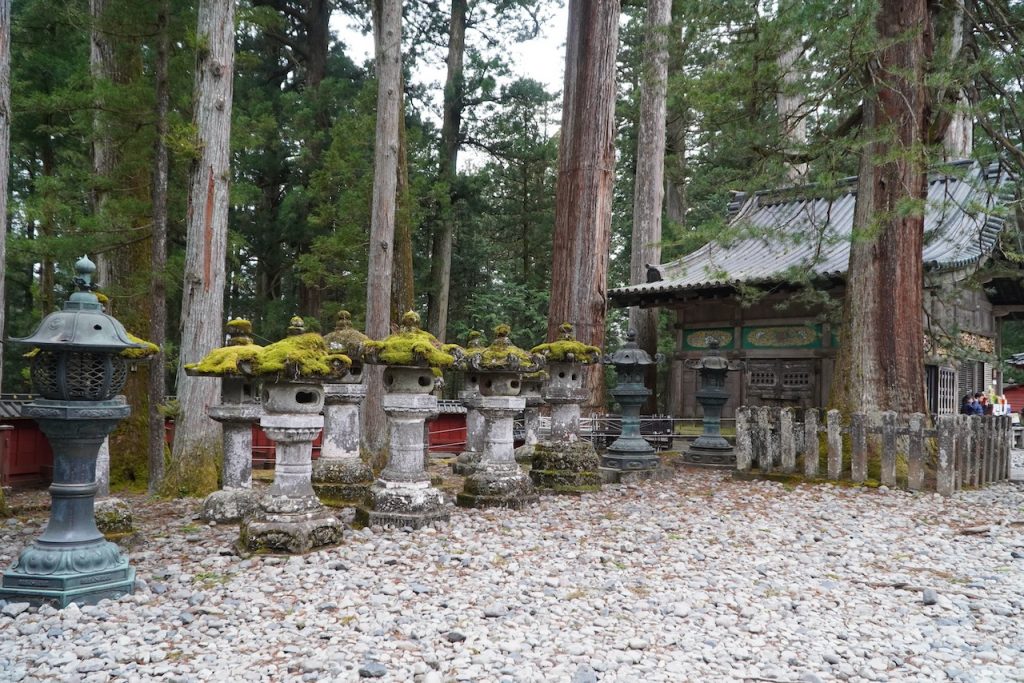
For your entry fee, you get the privilege of walking up 207 steps, each made of single stone, to see his tomb. There’s a sleeping cat carved into the gates on the way to his shrine. I’m here for the cat and for the trees.
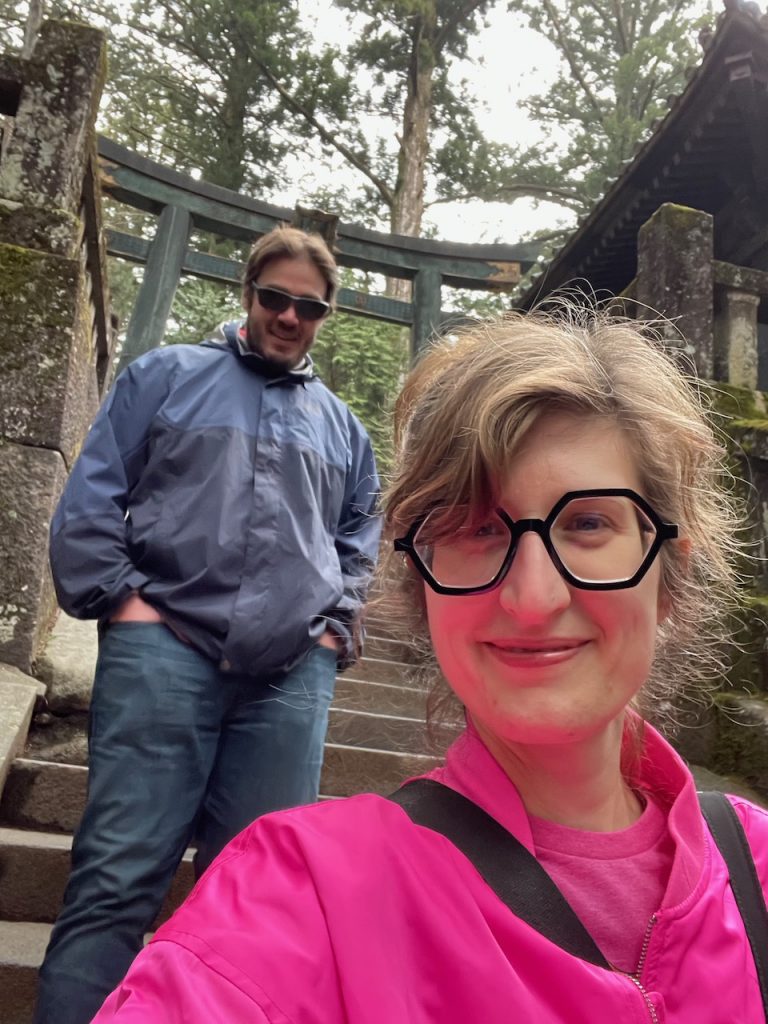
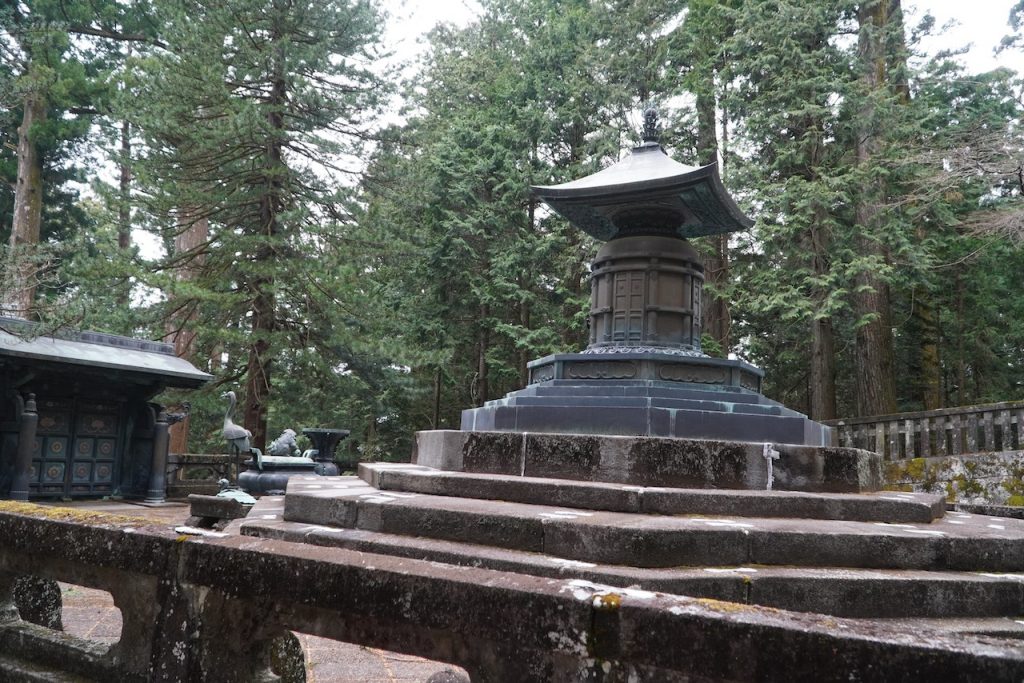
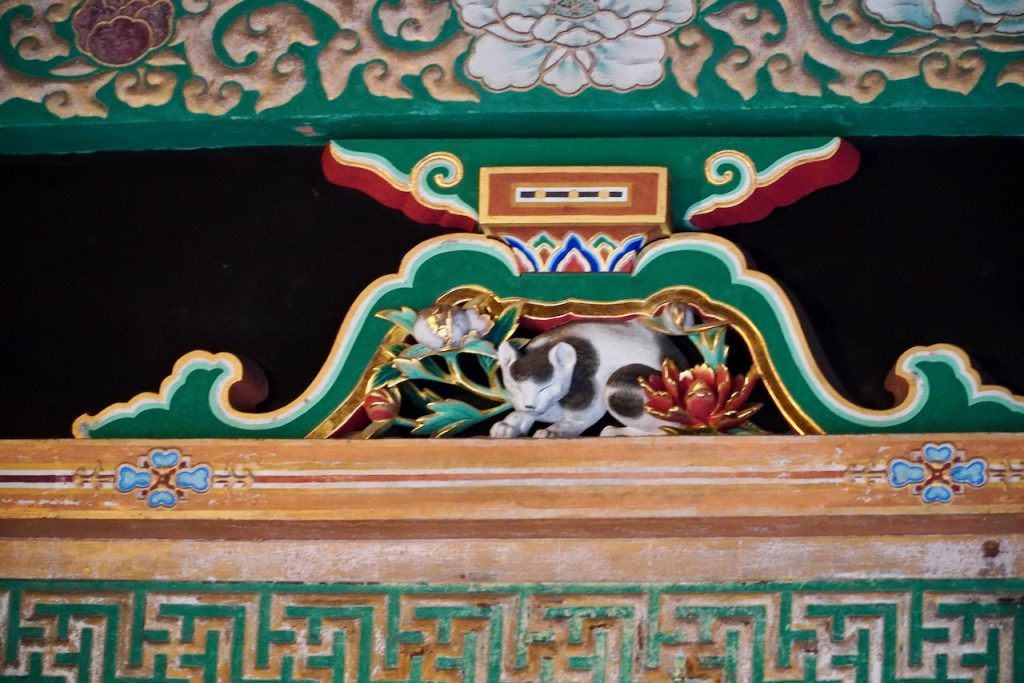
I think I skipped the museum the last time I was here. We made sure to pop in to see recreations of the portable shrines and Ieyasu’s swords and swords that were gifted to him posthumously, which I am certain he treasures. The swords are pretty shiny and sharp. There are also huge scrolls depicting his life and invitations he’s gotten, dating back to the 1600s. They are perfectly, meticulously preserved. No pictures are allowed so just picture katana in your mind.
🗡️ <- I am helping you
Oku-no-in Tokugawa is down a weird, very narrow street, past some run-down looking logging and scrap metal yards, in a very unassuming building. They valet the car and the inside is luxurious. We enjoy a welcome tea and a sakura-flavored daifuku (a rice snack) while we check in. Our kaiseki is at 6:30pm and I am excite.
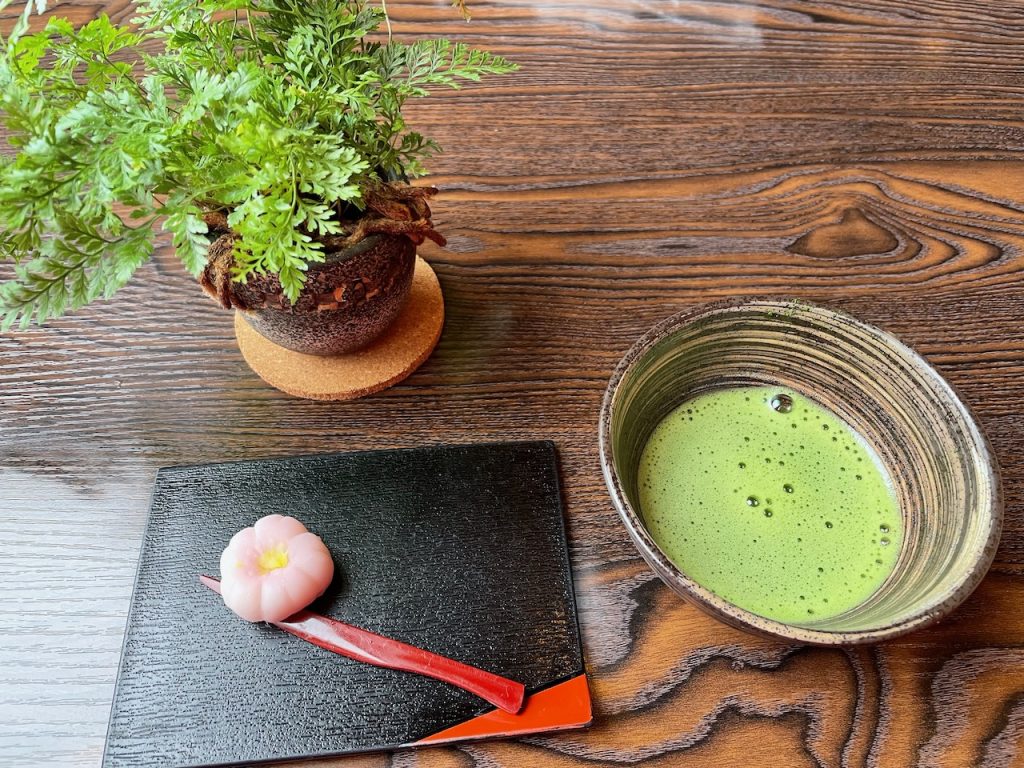
Our hotel room is Japanese-style, but two things are remarkable about it in this: the ceilings and transitions between each room are SO high and Rhett can’t hit his head, and we have a real live lounging couch. If you’re in a home, these aren’t so rare, but there’s been a lot of tatami-style floor sitting on this trip, which is not Rhett’s favorite. When booking, I was only looking out for showers that he can fit into and beds that won’t confine him, and forgot to think about the sitting spaces. Oh well. Next time.
Our suite features an outdoor bath, a water garden with a patio, and some bamboo. They give us yukata to wear, and Rhett fits into it. The toilet salutes you by opening its lid when you open the door. The floor is strategically heated. It is the best.
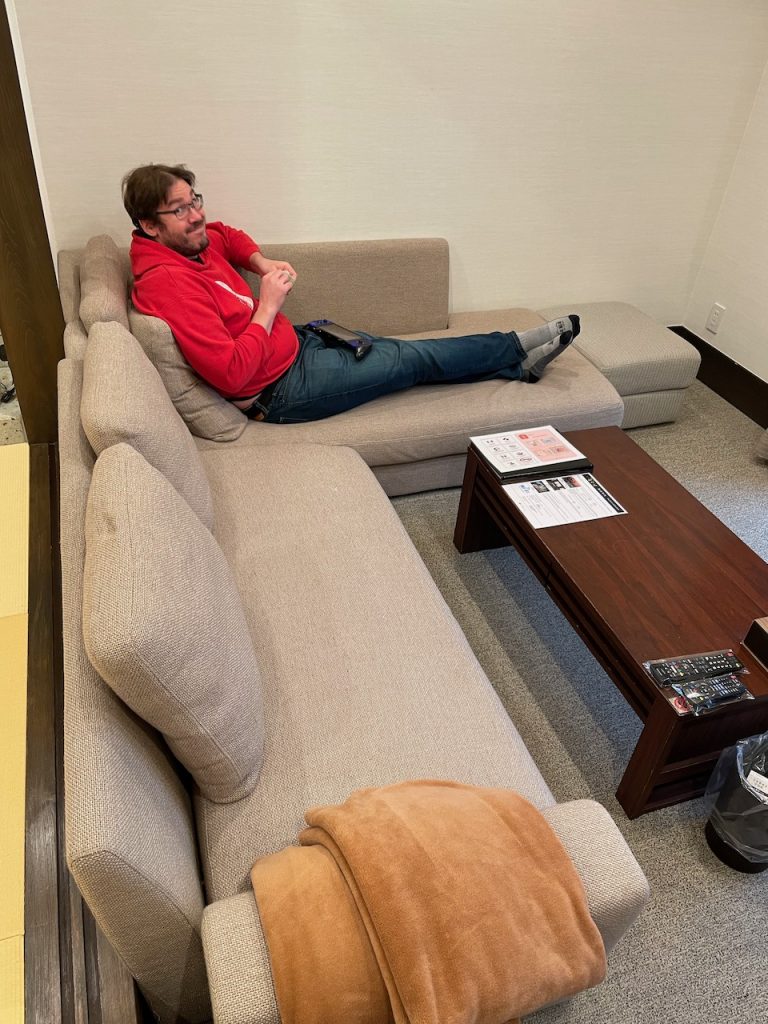
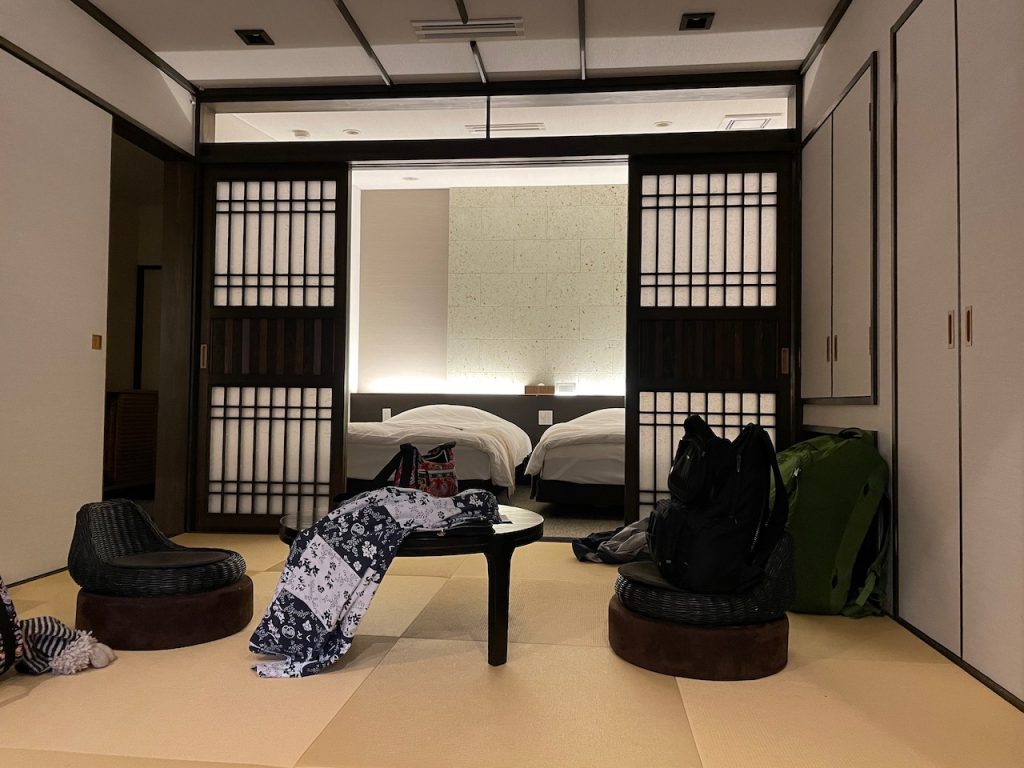
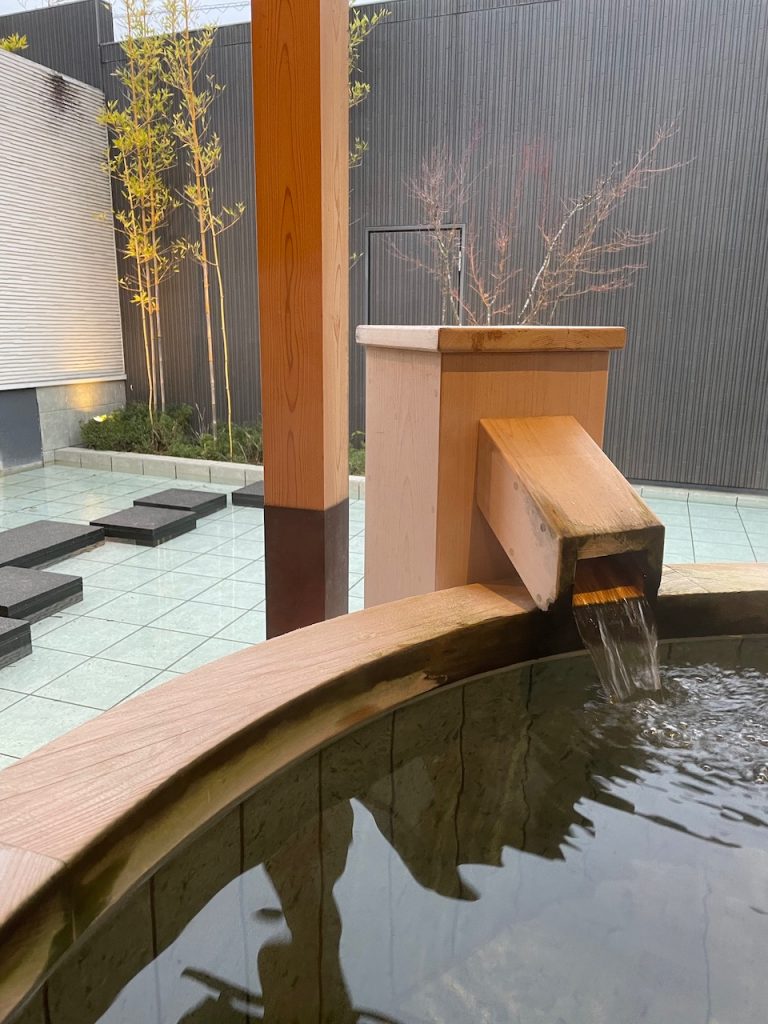
True to the negotiations, my dinner was perfect. I had a lot of yuba, a style of tofu that is kind of like if tofu were an al dente noodle. They also gave me lots of eggplant and mushrooms. It was all heavenly. Rhett tried a lot of fish and was definitely put off by the sea snail. The shabu-shabu with A5 wagyuu beef was his favorite.
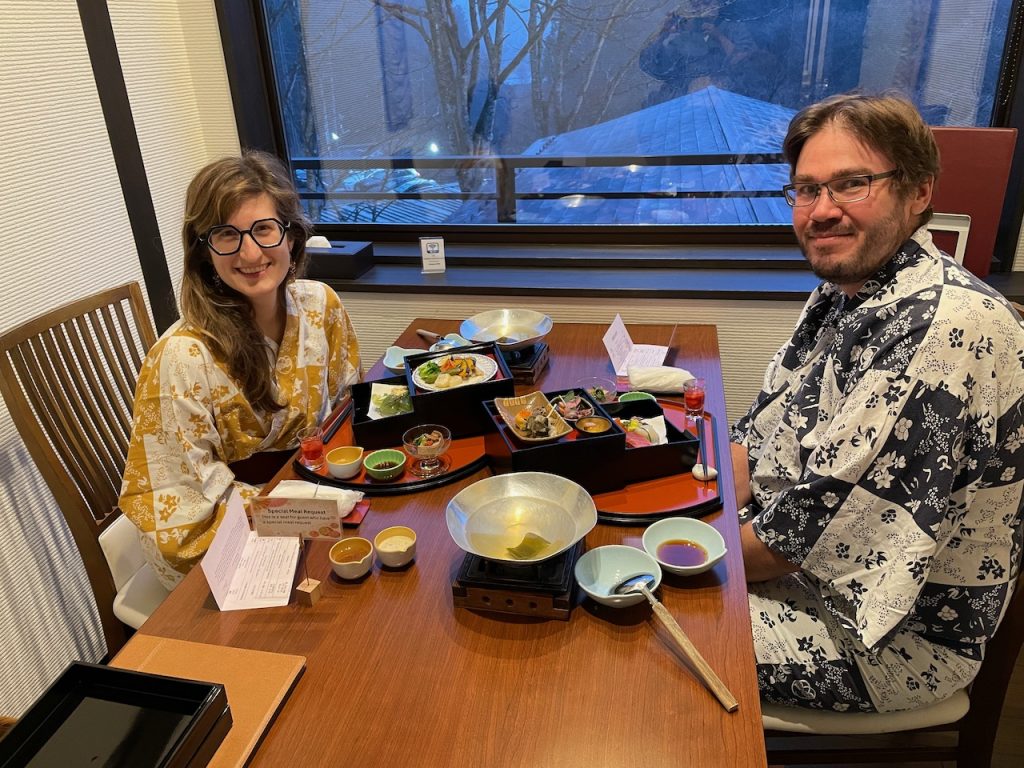
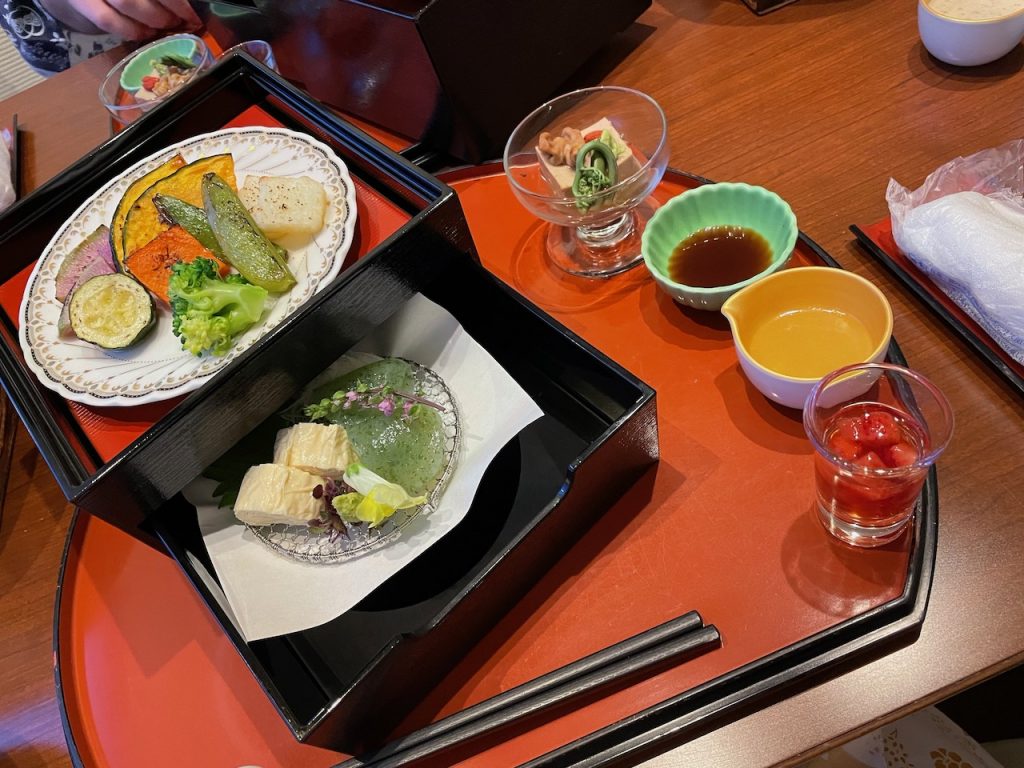
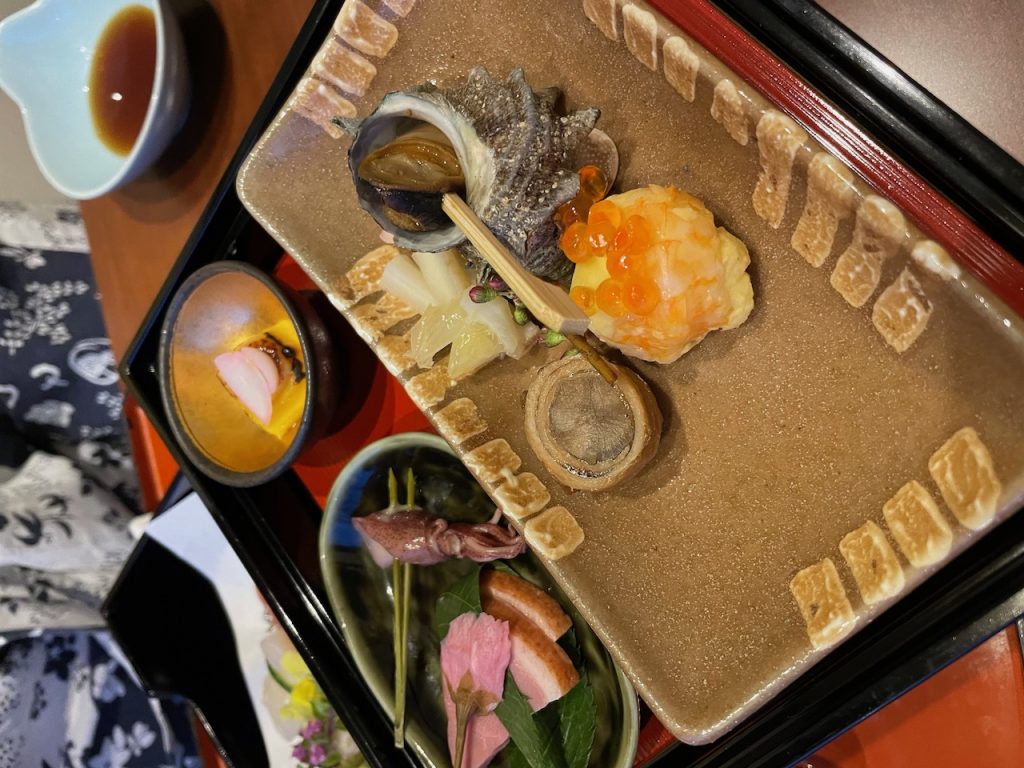
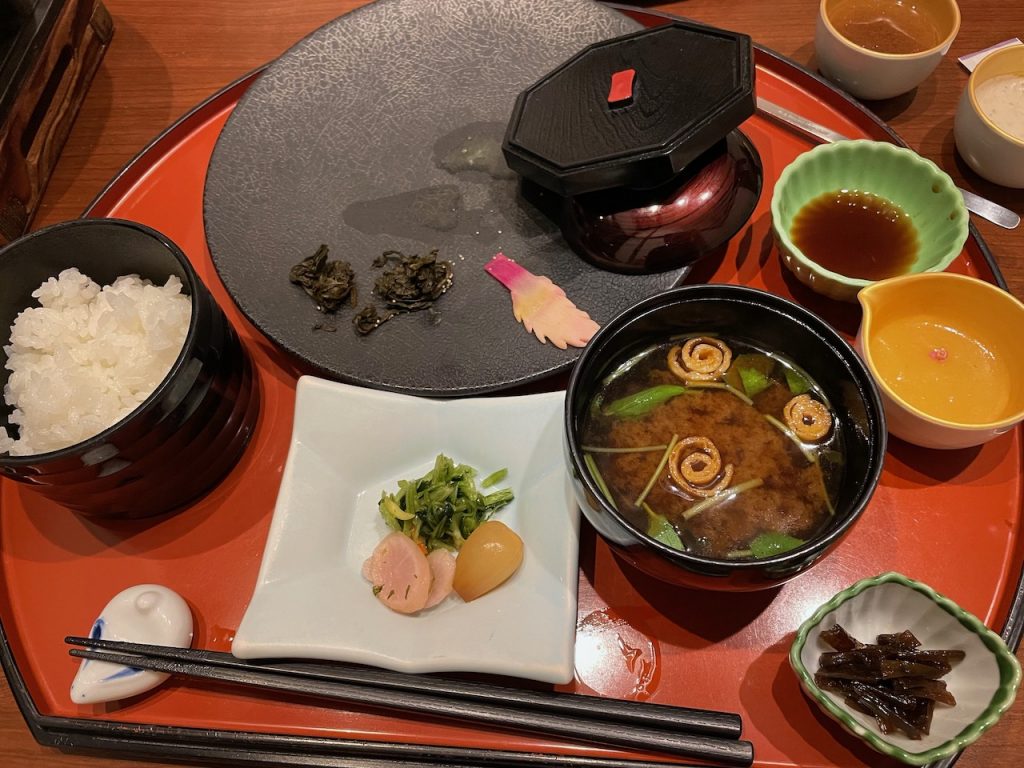
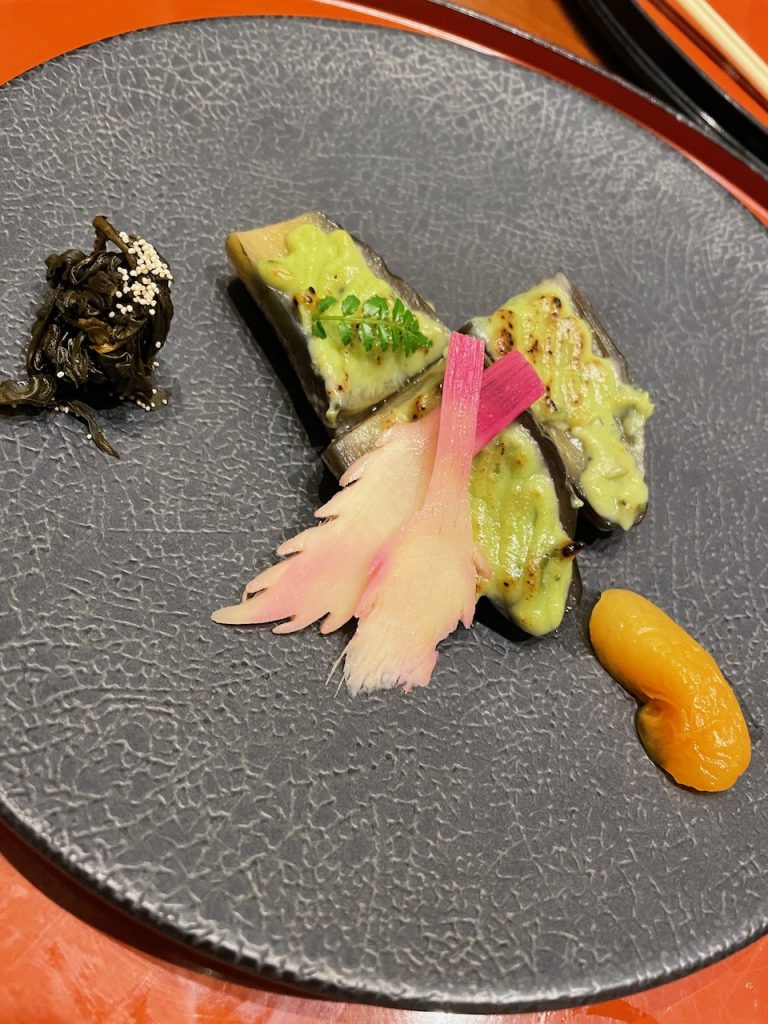
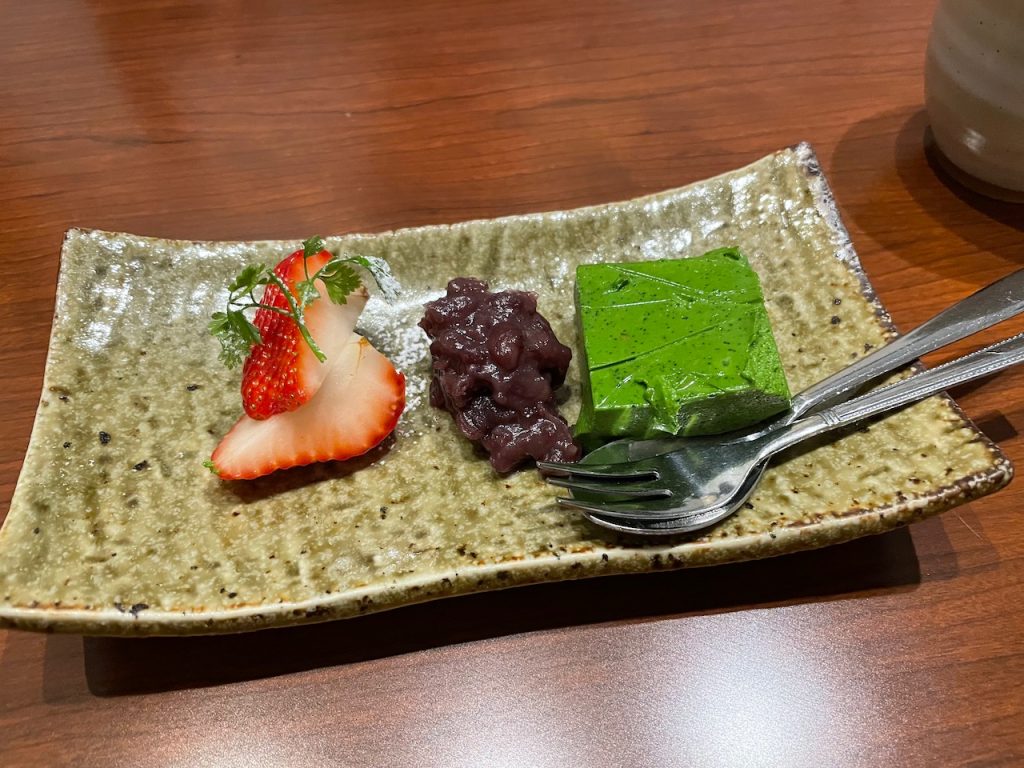
And as to not bait and switch you, here’s the small squid Rhett tried
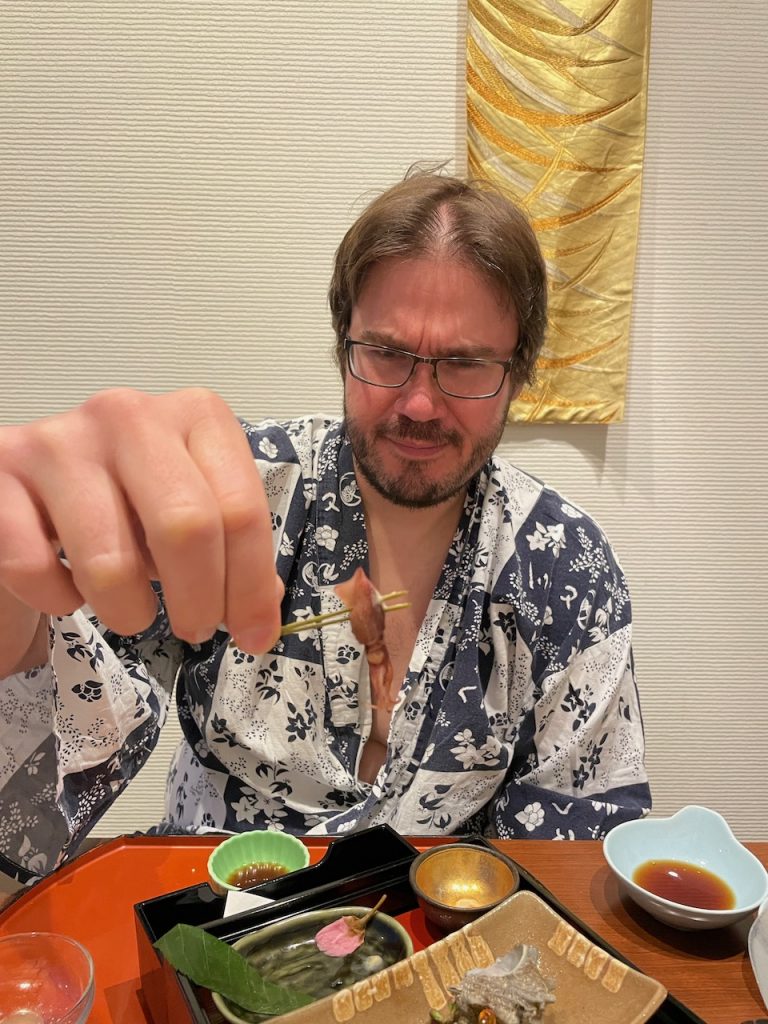
The hotel tries to murder you with food. Breakfast is also ginormous – a traditional japanese breakfast with several pickled sides (tsukemono), more yuba for me, and a tofu pudding for dessert. I won’t be eating for the rest of the trip.
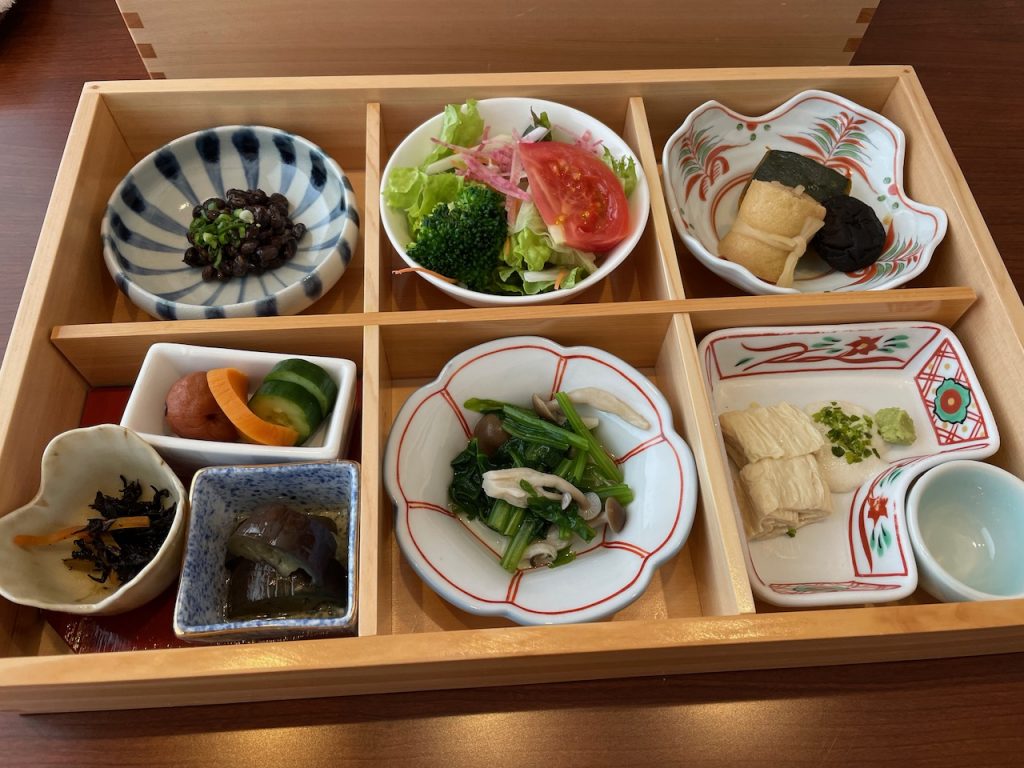
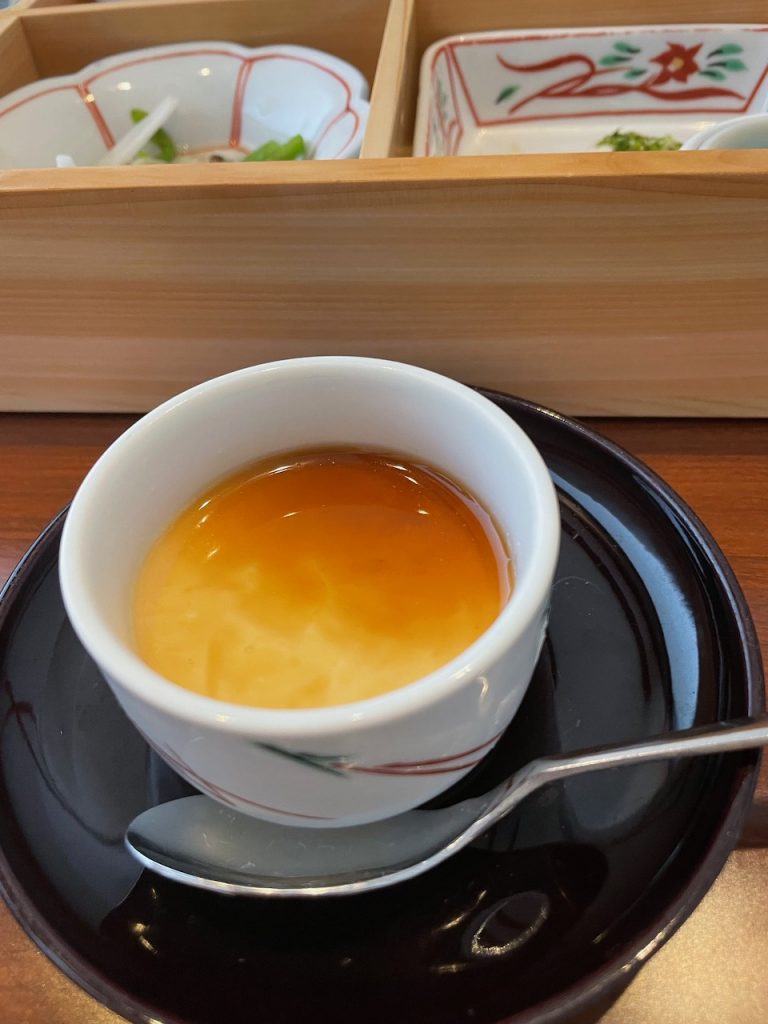
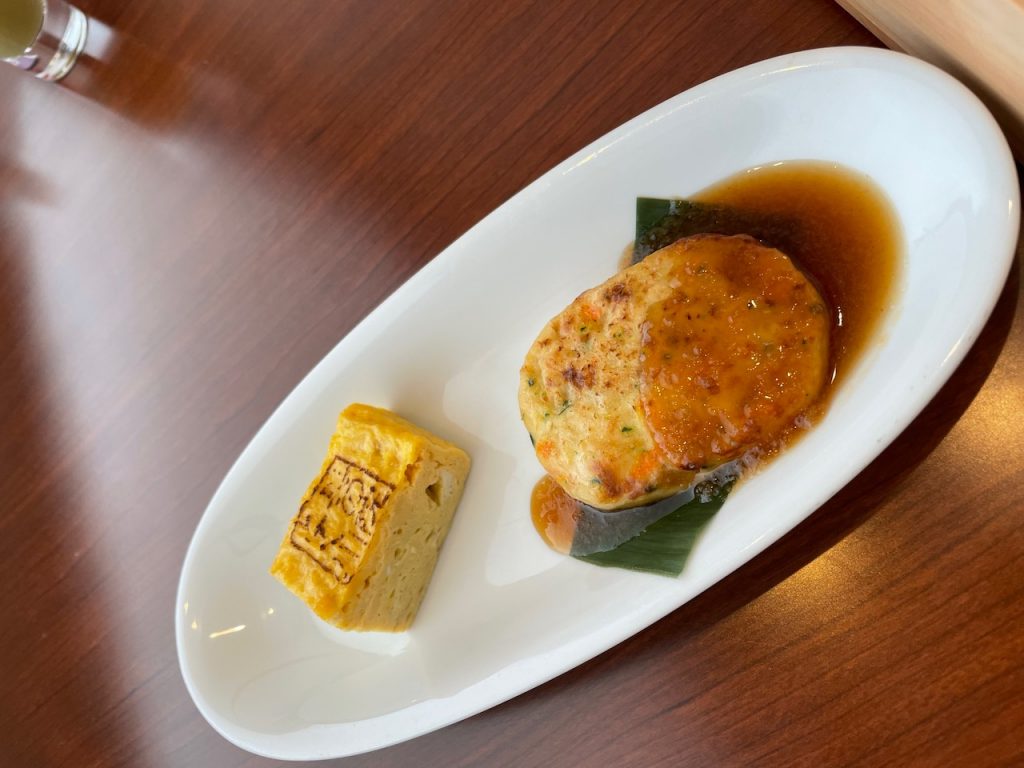
We stay in the hotel as long as possible to soak in the luxury and keep Rhett’s noggin in safety, and then we head out in the care to go up and over the mountain pass.
The drive is a pretty easy one, and thanks to my relatively recent adventures in Scotland, I reacclimate to using the mirrors almost immediately as we wind up and thru the mountain pass. We’re going to Chuuzenji, the lake that’s just west of Nikko. The road is switchbacky but really wide, and after driving in some dense fog and thru a tunnel, we make it to Oku-nikko.
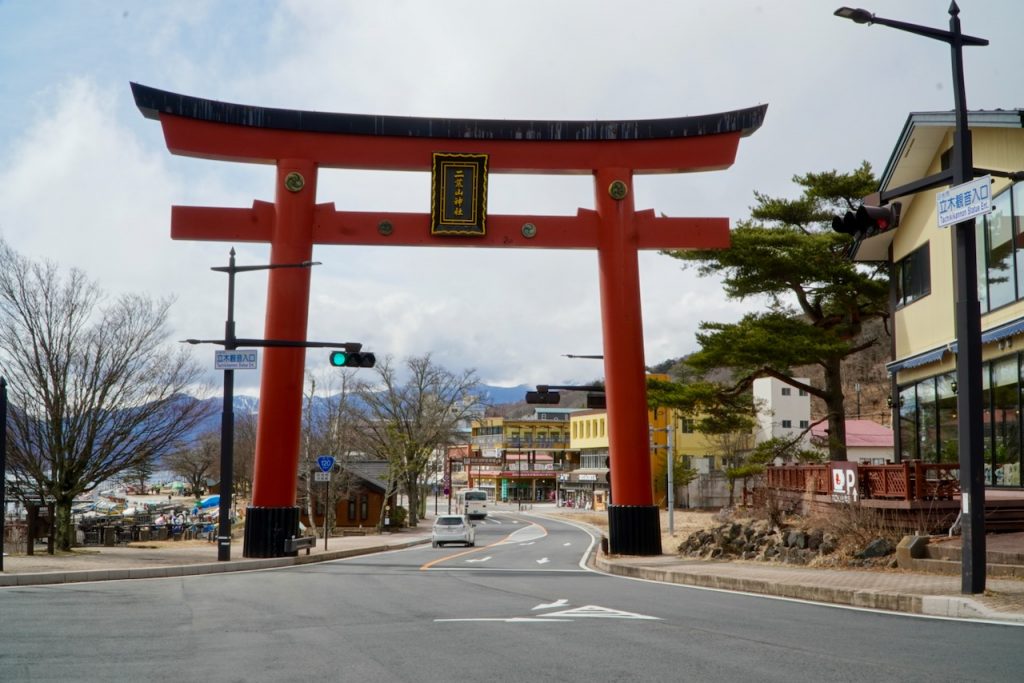
Oku-Nikko is mostly a Japanese resort town, equal parts kitzch, high-end hotels, and run-down and weird abandoned things. We are in Nikko’s off-season since there’s no cherry blossoms here yet and it’s really known for the lake and outdoor sports. The lake looks super low, maybe 20 feet less than usual. Sadly I forgot to make idle chit chat with the locals about wtf is up with the lake’s water level.
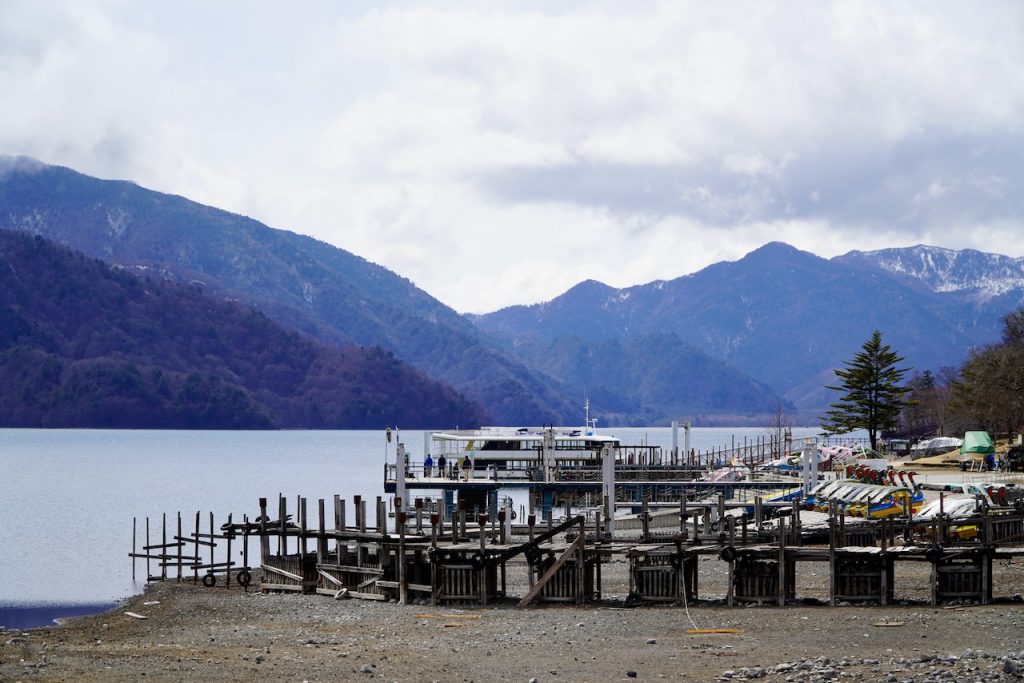
The lake is mysterious and moody with the fog passing through. We go to the waterfall at the north end and enjoy a coffee and an easy walk up and along ryuzu falls.
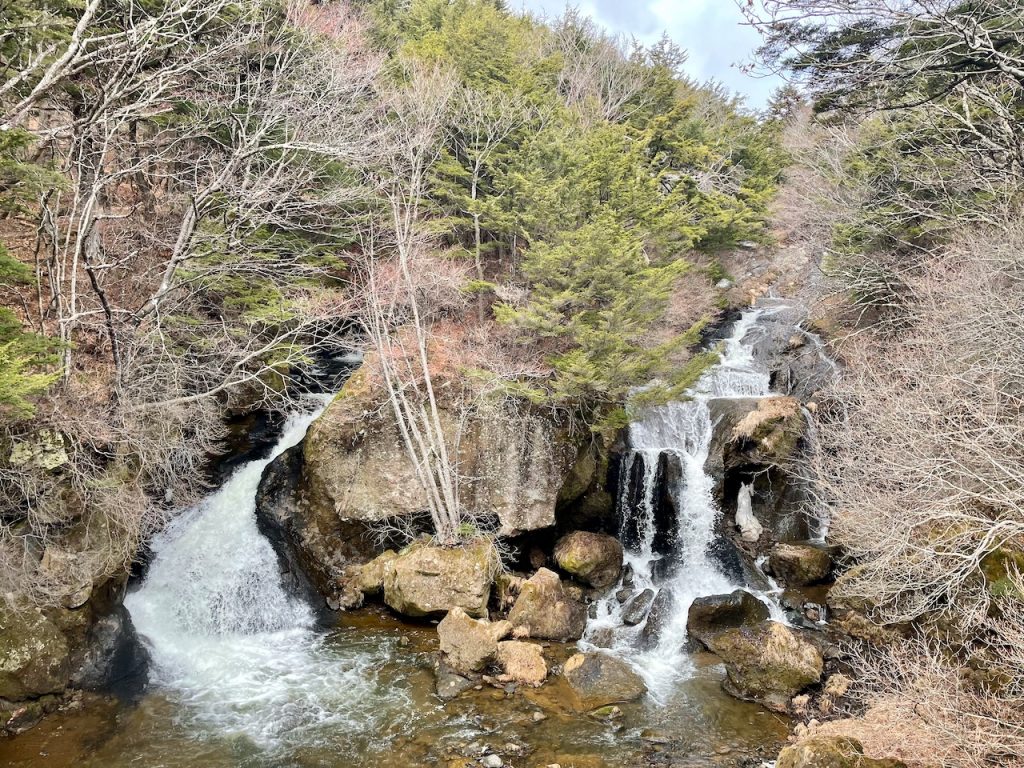
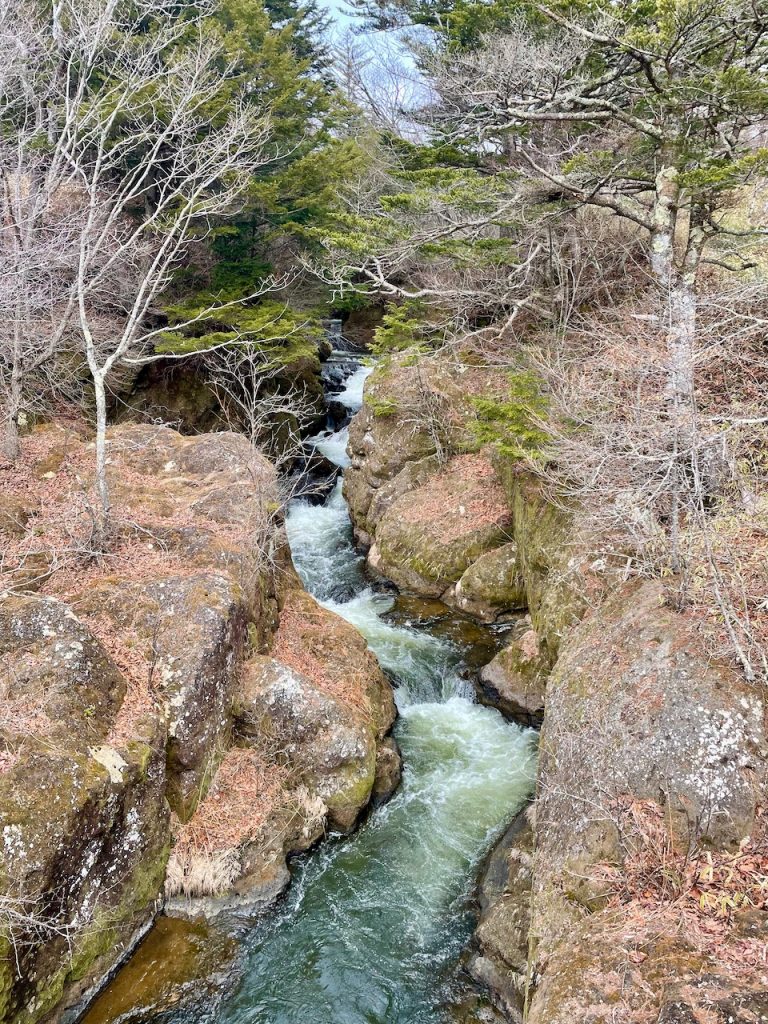
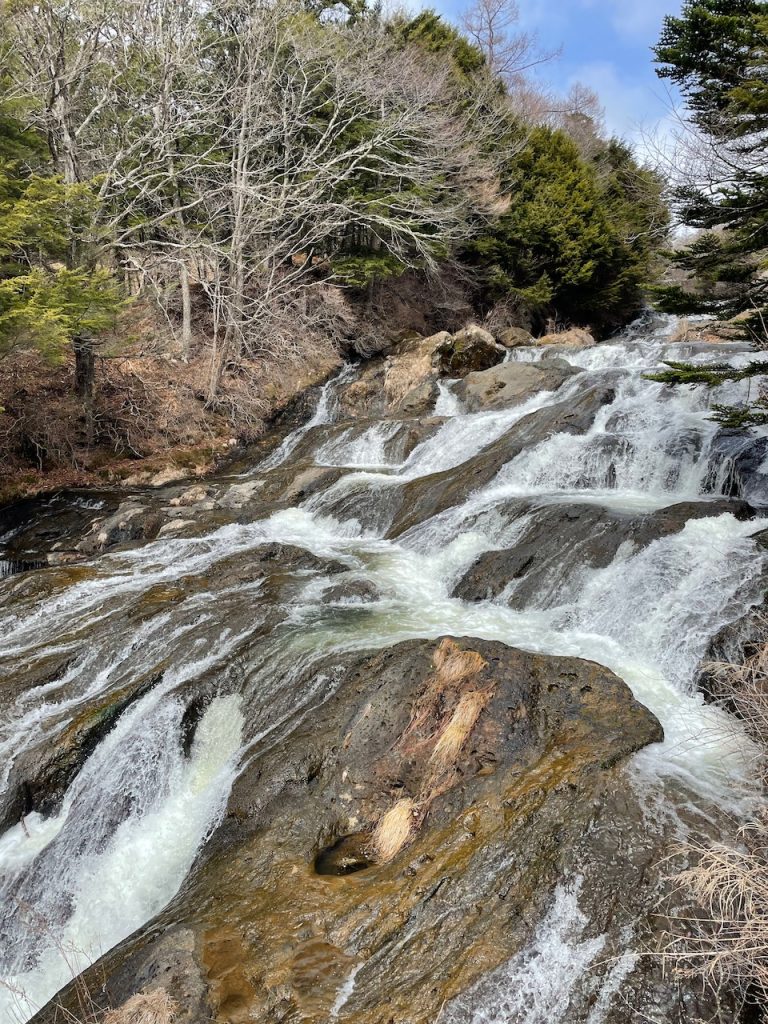
We stopped midway back at one of the shrines – Futarasan-jinja, named after the sacred mountain behind the shrine that you can ascend. The path doesn’t open until April 24th so it’s a ghost town. I cannot fathom the ascent to the top, which goes up thousands of meters to the summit. It’s said to be a spiritual experience, which I assume is just code for “you will die doing this.”
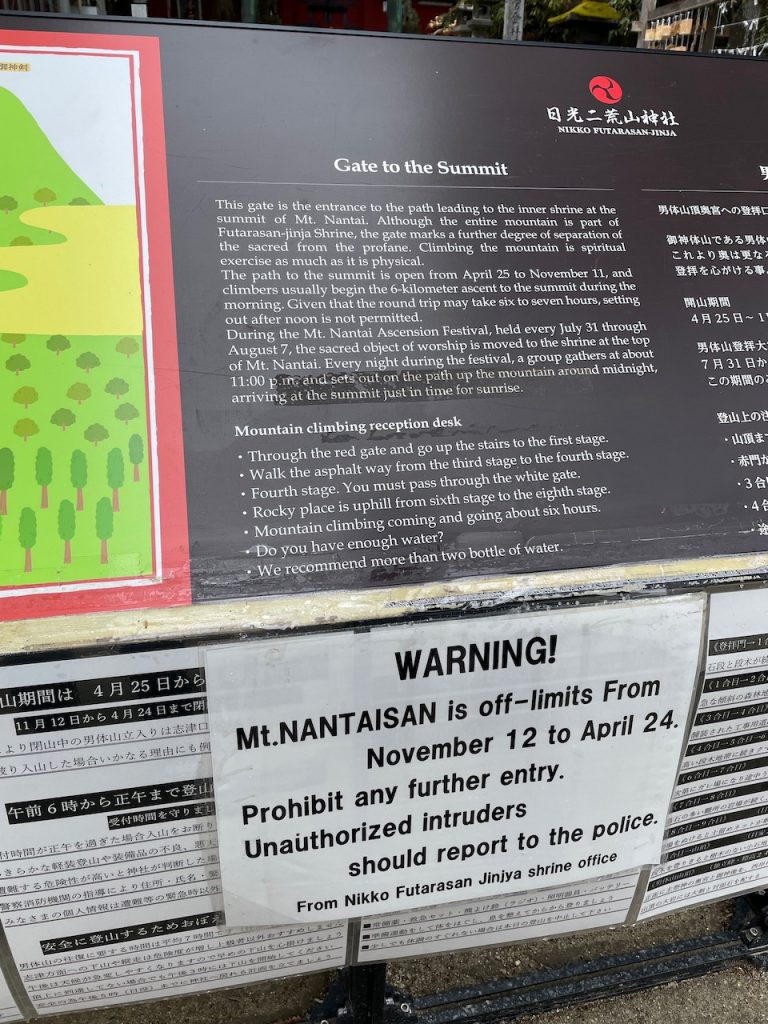
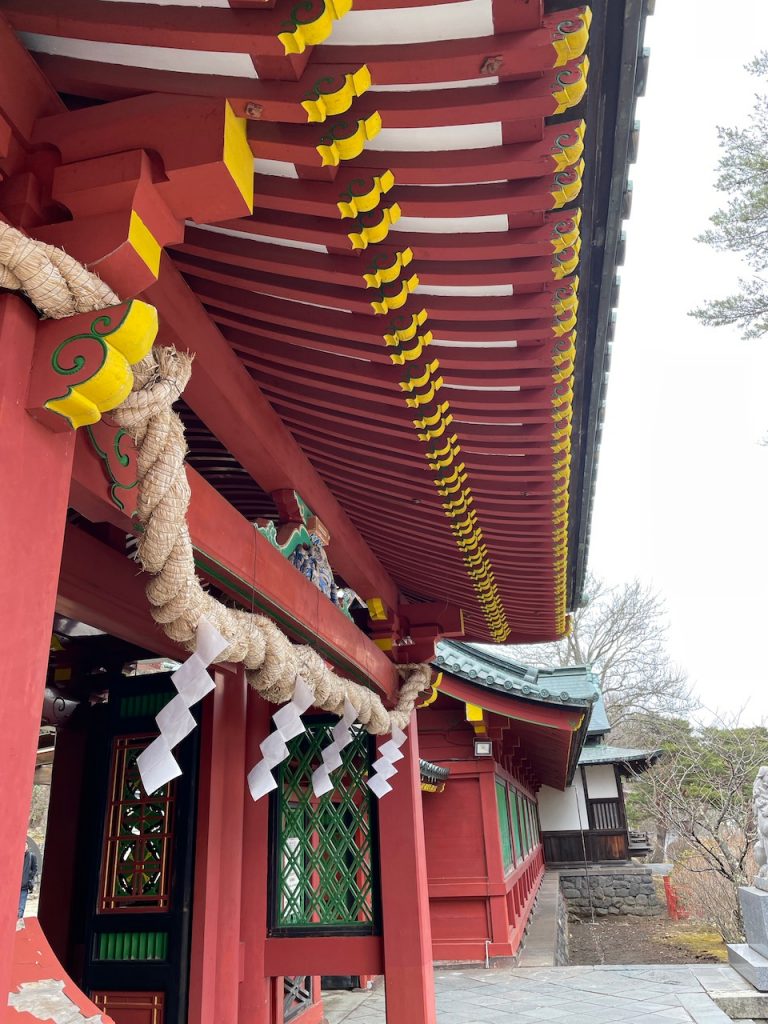
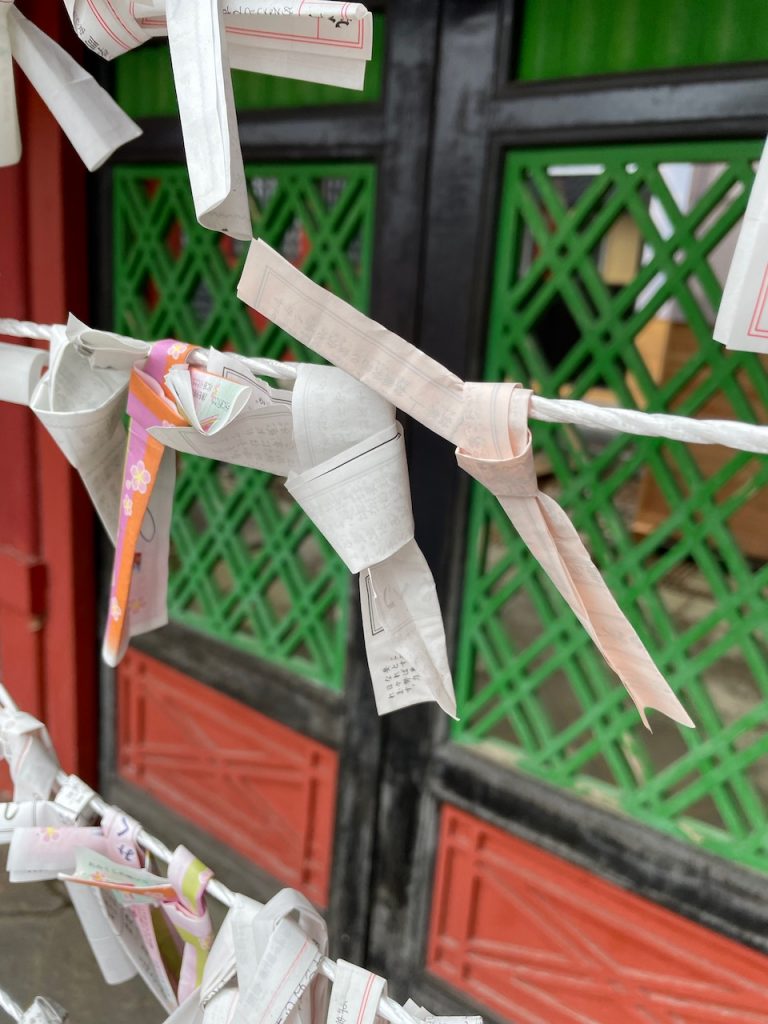
Futarasan-jinja happened to have a museum attached that had a ton of Japanese national treasure swords and the shrine’s portable shrines on display, including Japan’s longest sword. Sign. Me. Up. This was relatively small but IMO worth the 1k yen to enter.
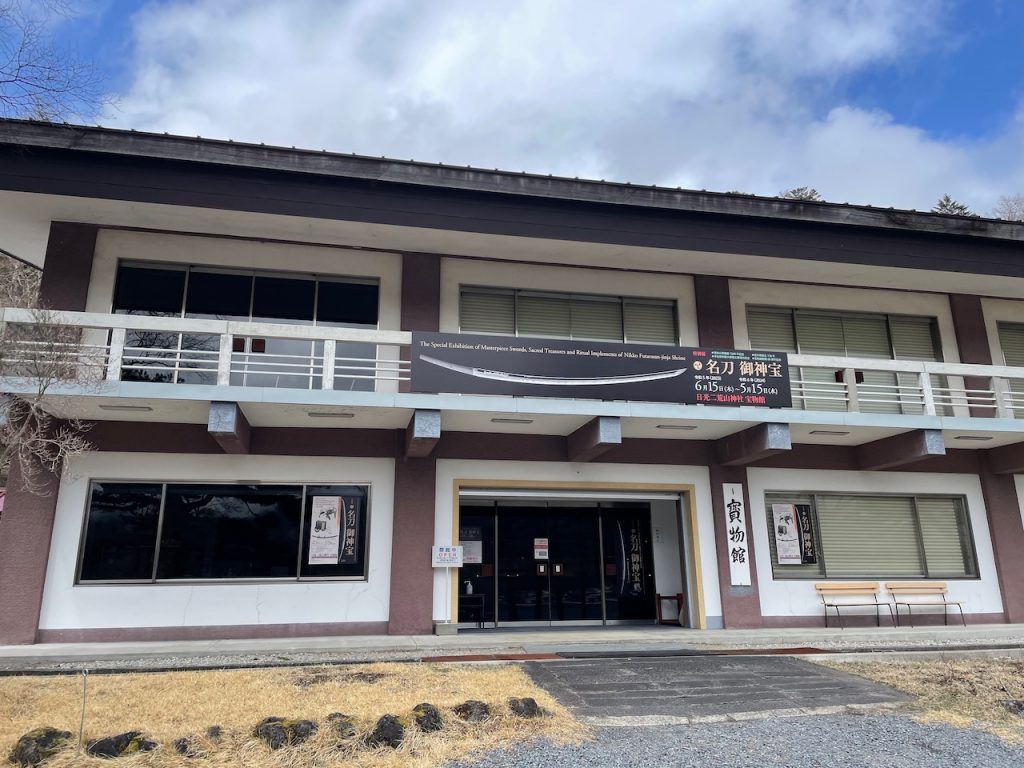
Japan’s longest sword is several feet long and was mostly used in ceremonies, and gets carried to the top of the mountain once a year as an offering to the gods. No pictures again, but just picture a really long sword that is 140cm long (or 7.7 bananas, for the American audience).
There’s a video on the swordmaking process. It’s all in Japanese but google translate helps with the very difficult and sword-technical signposts. We learned that they take the portable shrines up the mountain once a year and somehow everyone survives. This is bananagrams.
We get some coffees afterwards and Rhett’s matcha latte has some next level tiger art in it.
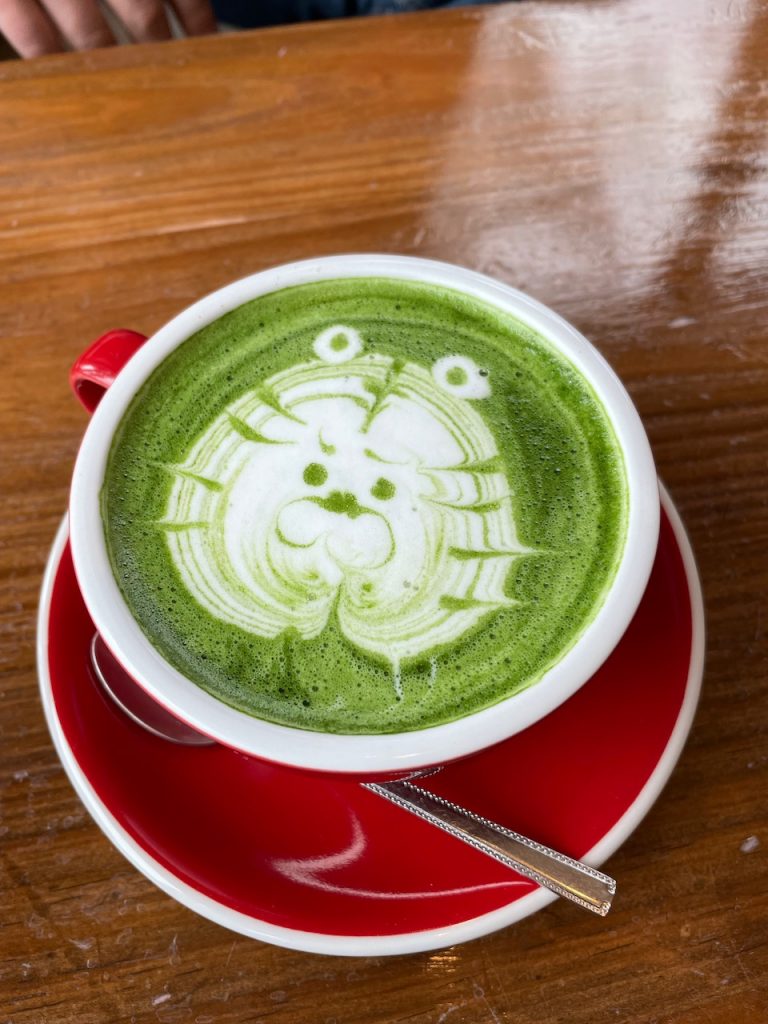
We skip Kegon falls because it is a zoo and go back through the pass to Nikko proper, stopping to walk along the kanmangafuchi abyss along the way. It follows a raging stream and is lined with jizo statues. There are like ten people here, which annoys me because the last time I was here, it was just me and the beware of bears sign. It’s still really beautiful and the water is an unbelievable shade of turquoise.
Also, the beware of bears sign is gone. I assume this is because Japan is trying to lose some tourists.
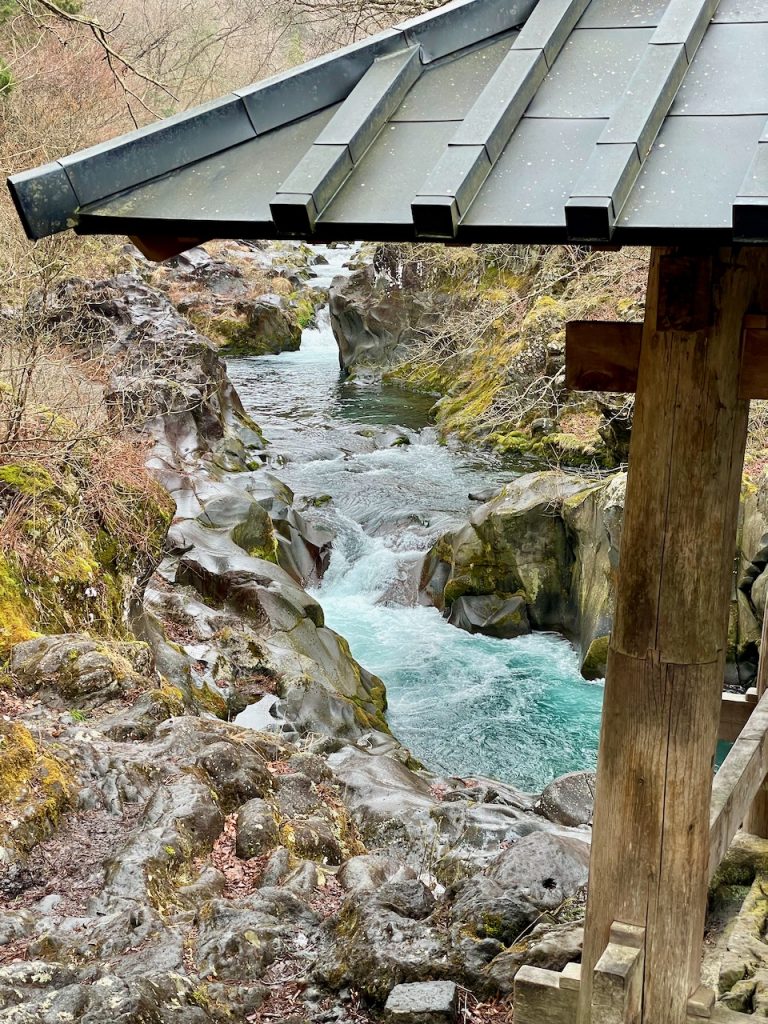
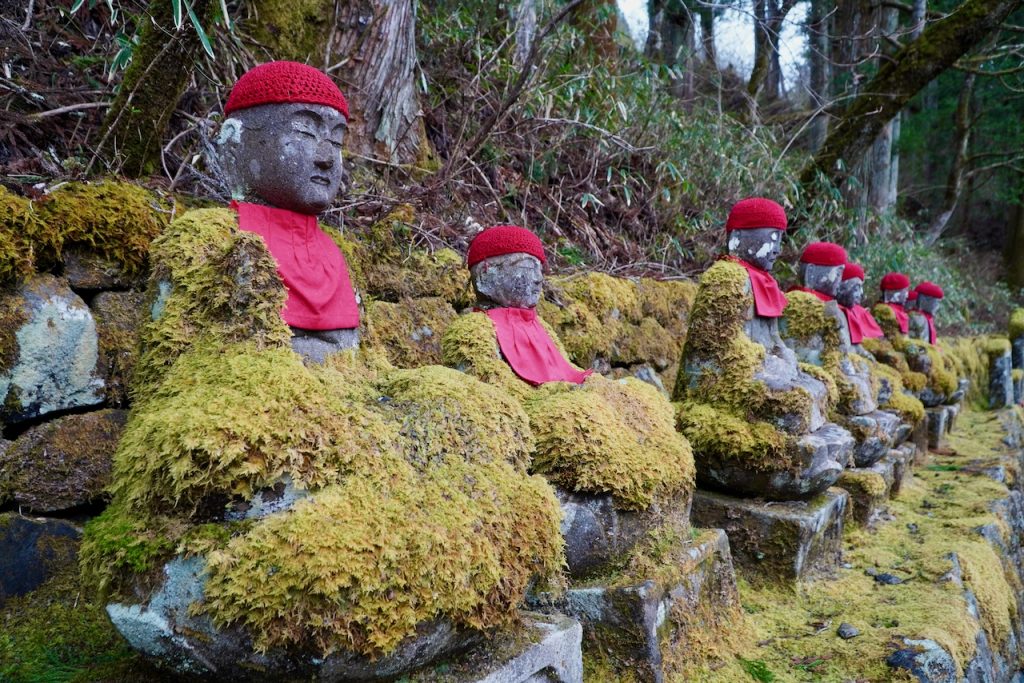
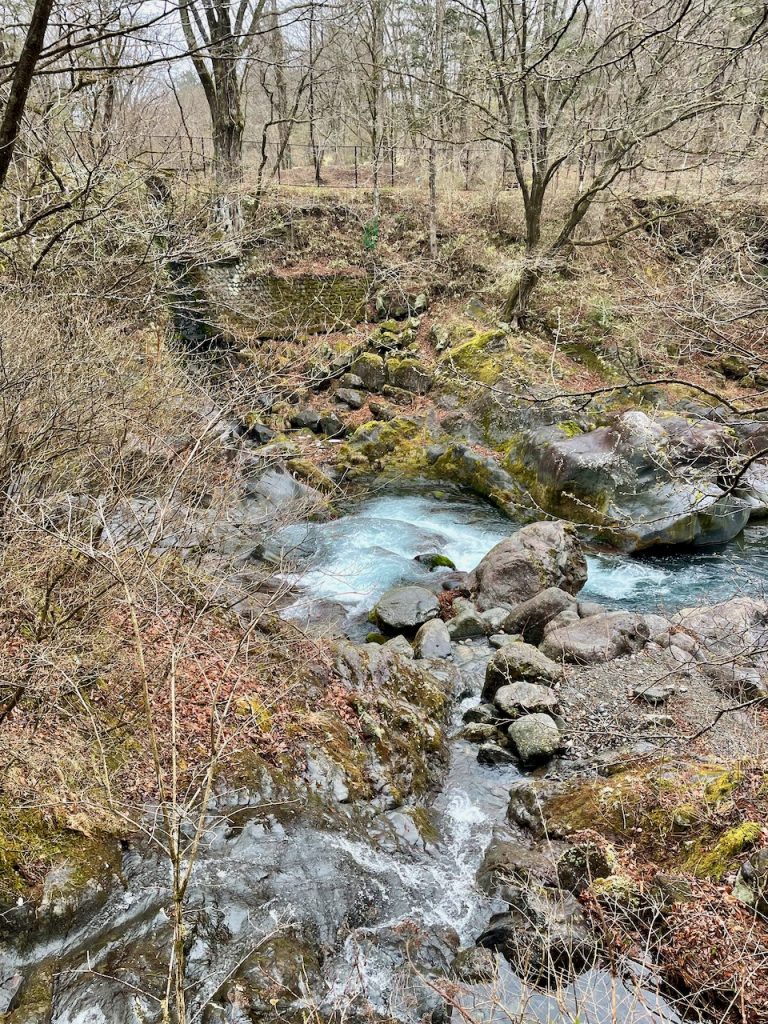
When we leave Nikko, it is the very last fancy train of the trip: the newly-released Spacia X train, which runs from Nikko to the east side of Tokyo. I booked a compartment for the two of us, and it’s also got a cockpit lounge, a bar car, and some other fancy seats. It’s a really special experience, with a lot of extra customer service around the bar car, pictures, and boarding.
It’s just under two hours and I love the peace and space we have in this compartment. Even if you don’t book a compartment, it’s a great way to travel between the two places in style.
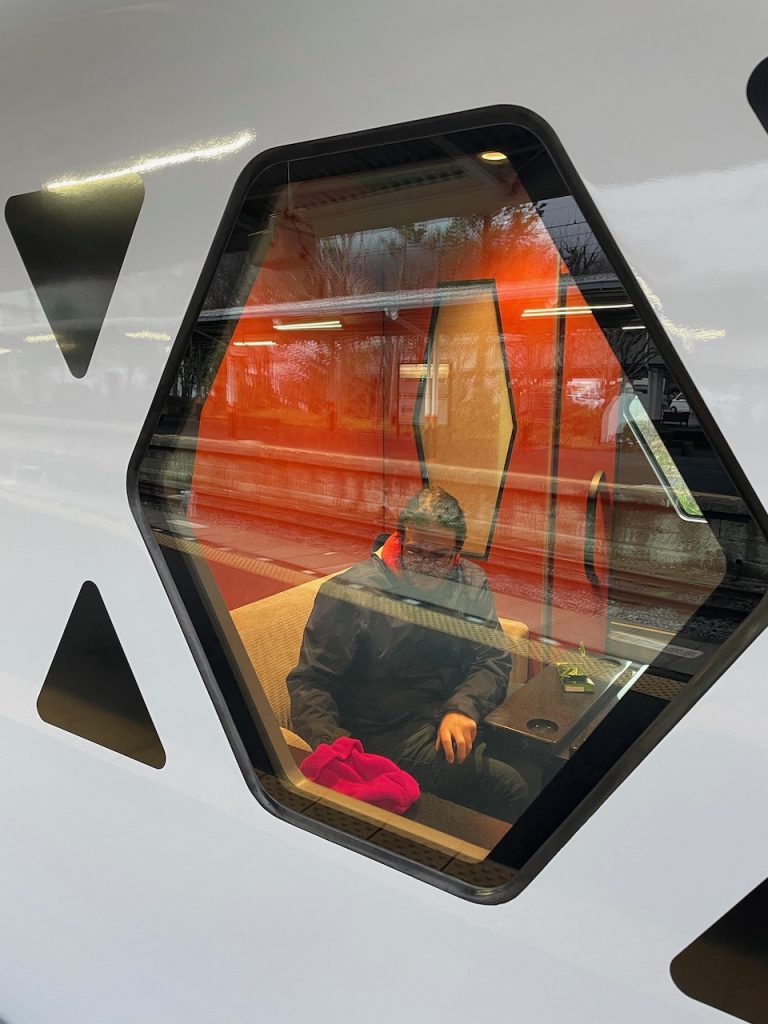
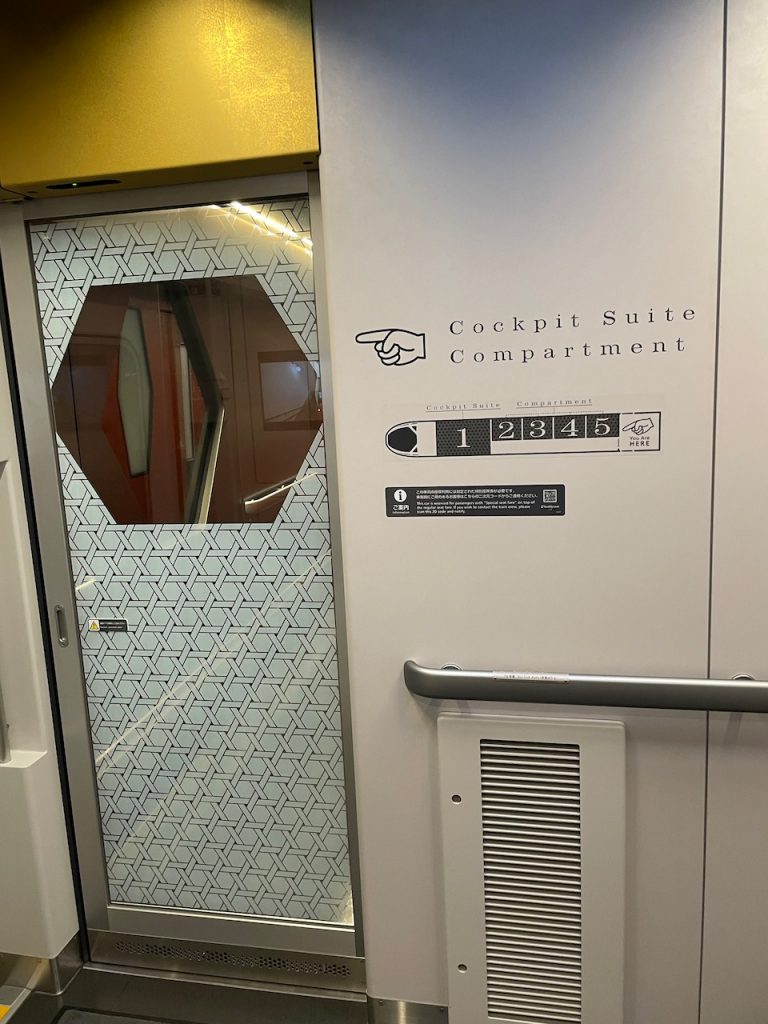
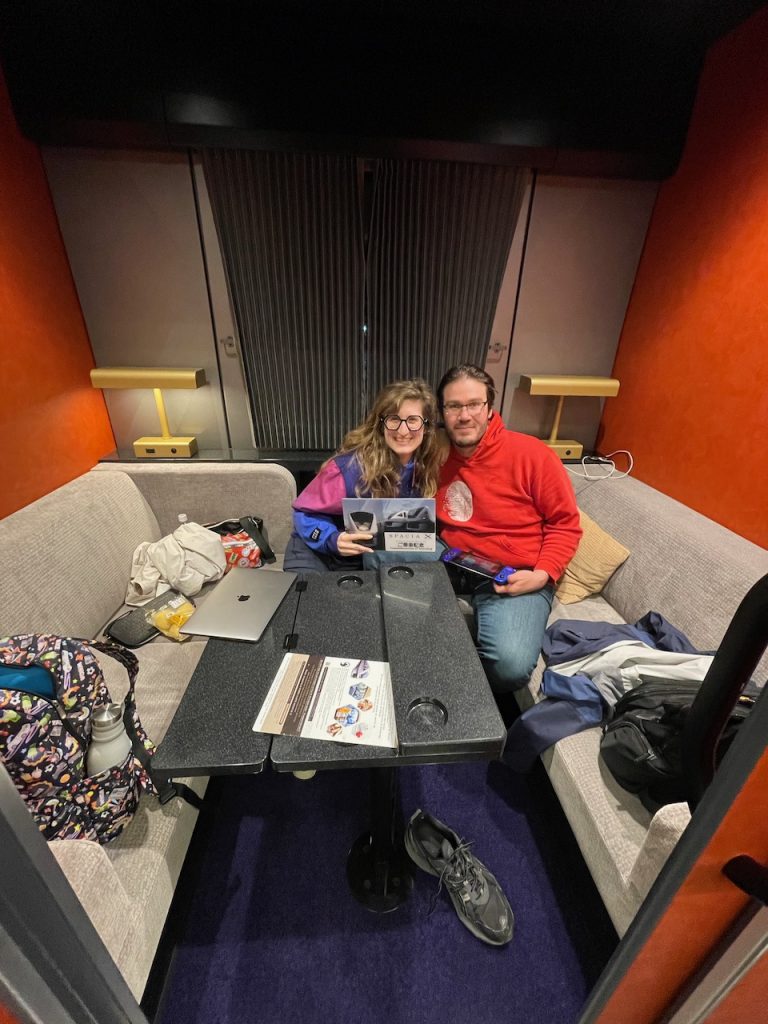
I will leave you with this train with a face. A friend pointed it out to me and I can’t un-see it.
